Summary
Foxes are known to harbour a range of different parasites, both internally and externally, including various species of intestinal worms, flukes, lungworm, heartworm, ticks, mites, fleas, protozoans, bacteria and fungi. Some of those of greatest concern owing to them being zoonoses (i.e., can be transferred to humans) include Toxocara canis (dog roundworm), Echinococcus multilocularis (hyatid worm) and Trichinella spiralis (muscle worm). Toxocara is present in the UK, although we currently don't have evidence suggesting that foxes are a significant link in the "infection chain". Echinococcus is currently considered by DEFRA to be absent from Britain, while cases of Trichinella British foxes are few, averaging about one per year.
Angiostrongylus vasorum (canine heartworm) and Sarcoptes scabiei (mange mite) are also important parasites of foxes that can be passed to domestic dogs. In Britain, the average prevalence of the heartworm is 7% (although locally prevalence may reach almost 30%) and it is widely considered that slugs and snails are a more significant source of infection than foxes. Mange can be a significant problem and cause large-scale declines in the fox population; the mites can be transferred to domestic dogs, but infection is easily treated.
Possibly the pathogen of greatest concern is rabies, for which the Red fox is the major sylvatic (wildlife) carrier in Europe. The virus is transferred through a bite and can be fatal to both humans and other animals (including foxes); large scale vaccination of foxes has served to control the spread of rabies in recent years, eradicating it altogether from parts of western Europe. Foxes are also capable of carrying bovine tuberculosis (although apparently aren't infectious) and Weil's disease, although they aren't considered significant vectors for either disease.
The Details

Contrary to popular misconception, Britain's fox population seems generally healthy, although there are still pockets of severe mange infection in parts of the country. In the International Fund for Animal Welfare's 2006 report After the Hunt -- The Future of Foxes in Britain, Stephen Harris and Phil Baker concluded:
"Like most wild mammals, foxes carry a range of diseases. There is no current evidence that these pose a significant disease risk to humans and/or domestic animals, although more monitoring is needed to determine the prevalence of current disease levels and assess their potential economic impact."
Broadly-speaking, parasites can be divided into two groups: those that live inside the host (endoparasites) and those that live on the skin/fur of the host (ectoparasites).
The endoparasites
The most common endoparasites of foxes are worms and, in a paper published in the journal Parasitology Research during 2003, Valdmir Shimalov and a colleague at Brest State University in Belarus (eastern Europe) presented their analysis of 94 fox carcasses and 1,213 faecal samples collected from Southern Belarus between 1981 and 2001. The scientists found a total of 32 helminth (intestinal worm) species -- including Alaria, Pearsonema, Taenia, Toxocara, Trichinella larvae and Ucinaria -- all of which are considered significant for medical and veterinary health.
A similar study of foxes from metropolitan Copenhagen (Denmark), published in 1996, looked at 68 carcasses and found many of the same helminths, with 86% of animals carrying Uncinaria stenocephala (a hookworm), 81% with Toxocara canis (a type of large roundworm well known to infect dogs), and 28% with Angiostrongylus vasorum. A team of ten biologists from the UK and Germany carried out a study of 588 foxes from across Great Britain to look at disease-causing parasites. The results, which were published in Veterinary Parasitology during 2003, showed that the most common gut parasites were Uncinaria stenocephala and Toxocara canis, occurring in 41% and 62% of the foxes, respectively.
Among the parasitic worms, the species that are generally considered to be of most concern in the UK, because they're zoonotic (i.e., can be transferred to humans), are: Toxocara canis, Echinococcus multilocularis, and Trichinella spiralis.
Toxocara canis (the dog roundworm)
Toxocara canis is an intestinal worm that can cause toxocariasis in humans; depending on to where in the body the parasite migrates affects the syndrome experienced, which include ocular (blindness), visceral (fever, coughing, pneumonia etc.), asymptomatic (carrier) or covert (mild) infections. Much concern has been raised in the media following stories of children having been blinded by the parasite, although most cases are visceral and not serious. Infection is via ingestion of the eggs, which are generally picked up through contact with old faeces or contaminated soil -- the parasite develops in the faeces for several weeks before becoming infective, so fresh faeces aren't a source of contamination, although the eggs are very hardy and may persist in the environment for years. Simple hygiene (such as washing your hands before you eat) is an essential preventative measure. Unfortunately, there is still much to discover about this species, which makes it difficult to assess how important any given host species is in its spread. What we do know is that most infections in the UK (and, on their website, the Health Protection Agency note that there are about 100 cases of toxocariasis in Britain each year) originate from domestic dogs, although this parasite has long been known in wild foxes.
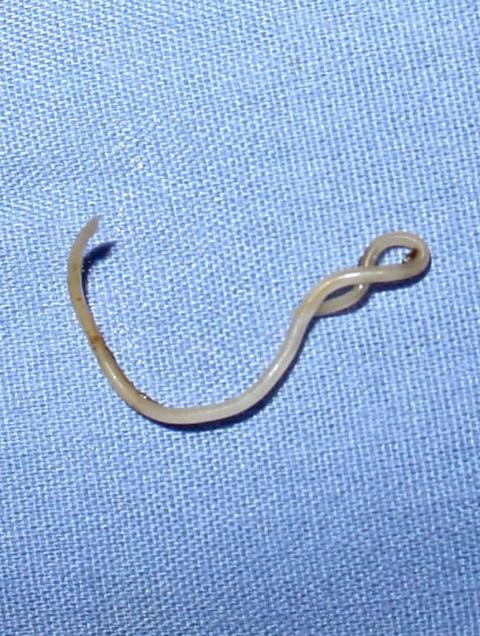
During his 1966 Ph.D. study at Liverpool University, Bertram Cook found Toxocara in half of the foxes examined, although burdens were low (only 13% had more than four worms). Subsequently, in a 1993 paper to the journal Parasitology, Royal Holloway biologists David Richards and John Lewis, along with Bristol University's Stephen Harris reported on the presence of this parasite in 521 foxes collected in Bristol between January 1986 and July 1990.
The biologists found that 58% of male and 44% of female foxes had the parasite and that young animals, cubs in particular, were more susceptible than adults; worm burdens were highest in cubs, lower in subadults and lower still in adults. The authors note that cubs appear to become infected either prenatally (i.e., while in the uterus) or in the days and weeks after birth; this happens via the colostrum while suckling, and by coming into contact with the faeces and vomit of littermates. This study also found seasonal differences in infection, with the parasite being more common during the spring and summer months, but found environmental contamination to be low. They recovered Toxocara eggs from 2% of the 100 soil samples they collected; a single egg from a fox earth, and a single egg from a daytime lying-up site.
The infection picture is still unclear for foxes: some studies have found higher infection rates among adults than cubs, some (including an extensive study of more than 1,000 foxes in Denmark) support the findings of Richards and his colleagues that cubs have significantly higher worm burdens than adults, while others failed to find any difference between adult and cub worm burdens. Indeed, in a 2001 paper to the Journal of Helminthology, Richards and Lewis found relatively high egg counts in the faeces of both cubs and adults -- with the largest number of eggs (2,145 per gram) recovered from an adult male -- suggesting that both adults and cubs can harbour considerable Toxocara worm burdens. Either way, the initial results presented by Richards and his team are similar to those obtained for dogs, which generally show that puppies are a much greater source of infection than older dogs.
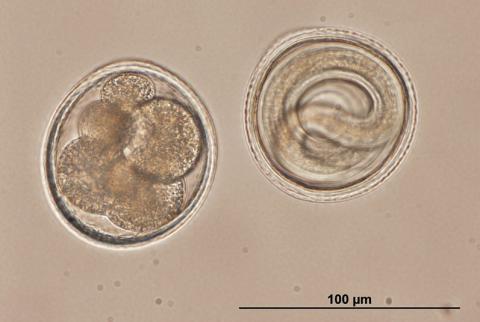
Despite many gaps in our knowledge, in recent years our understanding of this parasite and its transmission has improved. From Richards and Lewis' 2001 study we now know that there is no significant relationship between the number of worms an animal has and the number of eggs in the faeces, so one must be cautious about attempting drawing conclusions from eggs in scat. Additionally, it seems that eggs may be transferred via fur. In a 2008 paper, Gillian Roddie and colleagues at the University of Dublin report that, of the 87 foxes they studied, 24 (28%) had Toxocara eggs on the fur around their anus (61% had worms in their intestines). The number of eggs on the hair wasn't related to the number of worms in the intestines and neither factor was related to the animal's sex or age (although it should be noted that there were no cubs in the sample).
Interestingly, the study also suggested that eggs on fox fur may suffer more environmental degradation than those on dog fur, with just over twice as many unviable (essentially "dead") eggs on fox fur than dog fur. Despite these, and other, recent advances in our understanding of the disease, there is currently no evidence to suggest that foxes are a significant reservoir of Toxocara infection for either dogs or humans.
Echinococcus multilocularis (the ‘hyatid worm’)
Echinococcus multilocularis is a tapeworm that causes the potentially serious condition of alveolar echinococcosis (AE) in humans. The parasite is widespread throughout the northern hemisphere, in both North America and Europe, and causes tumours in the liver, lungs, brain, and other organs and, if left untreated, is often fatal; treatment can be both difficult and expensive. It is currently unknown precisely how many cases of AE occur globally each year; figures range from 18,000 to 500,000.
The tapeworm is carried by several members of the Canidae (dog family), including wolves, jackals, coyotes, and domestic dogs. Several studies have, however, implicated the Red fox as the main carrier in Europe, being largely responsible for the infection of humans by shedding eggs into the environment via their faeces. Foxes harbour the parasite in their intestines, which allows the worm to shed eggs into their faeces and subsequently pass into their surroundings. Once in the environment, humans, livestock (especially swine) and dogs can become infected.
Fox density has been correlated with Echinococcus multilocularis abundance in parts of Europe (notably Germany and Switzerland, where as many as 30% of the fox population may be infected), although the precise reason(s) for this association is unknown. Rodents act as intermediate hosts for the parasite (i.e., foxes get it from their prey) and some have suggested that the risk of infection may thus be associated with the distribution of the foxes' food. A recent study in France found that fox scats were deposited most commonly in areas with a high density of small-eared voles (Microtus spp.) and water voles (Arvicola terrestris). The fact that large populations of Microtus voles live on urban wastelands in France led the authors to suggest that the presence of this fox prey may increase the potential for transmission of this tapeworm. Indeed, a recent study of foxes collected in Geneva, Switzerland between 1998 and 2002 found that this parasite was more prevalent in rural (52% of foxes infected) than in urban areas (30% infected), which the authors attribute to fewer rodents in the latter habitat.
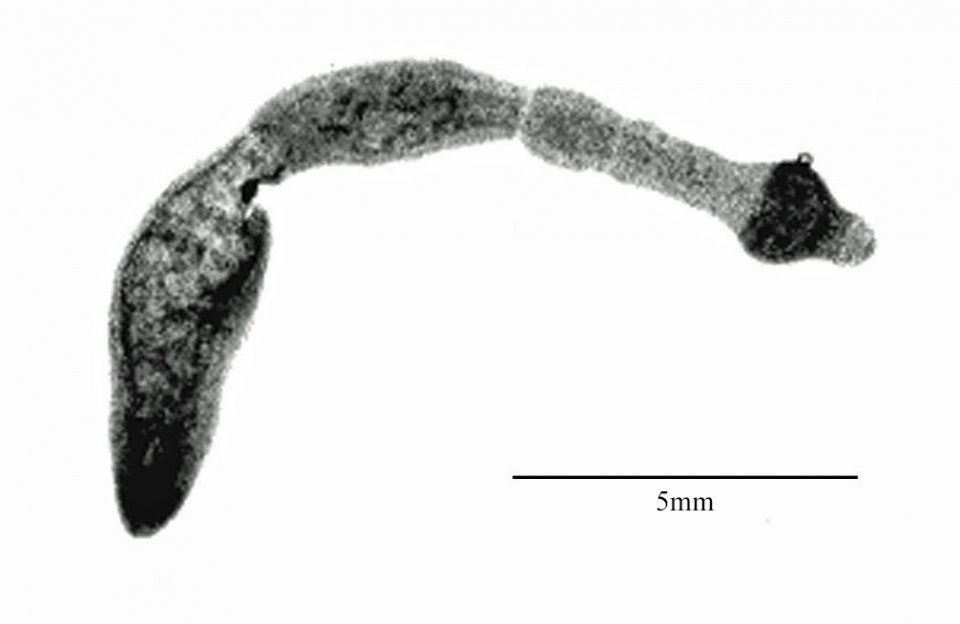
Echinococcus multilocularis is currently believed to be absent from Britain. Between 1999 and 2000, DEFRA tested 604 fox carcasses for various tapeworm parasites and did not find this species; a further 384 carcasses were assessed between 2005 and 2010 and all were negative for this tapeworm. DEFRA cannot say for certain that the parasite does not exist in Britain (they've not tested every single fox), but they do currently estimate that, if it is present, its prevalence is less than 0.1% (i.e., one infection per 1,000 individuals). Baiting foxes with anti-helminthic drugs (those that kill intestinal worms) has been used to decrease the prevalence of the parasite locally in parts of Europe, but there is currently no wide-scale solution to the problem.
There is another species of worm that causes a different hyatid disease in humans: Echinococcus granulosis causes cystic echinococcosis. There is only one record of this worm having been found in a fox from the UK, and this is widely considered to have been a misidentification of Echinococcus multiocularis. In 2009 there were nine reported cases of this disease among humans and all were associated with the consumption of imported meat.
Trichinella spiralis (the ‘muscle worm’)
Trichinella spiralis is a small parasitic roundworm, typically found in the muscle tissue of pigs, that is sometimes referred to as the "pork worm" owing to many cases of human infection following the consumption of undercooked pork. In humans the worm can cause trichinosis, a disease manifesting with various symptoms depending on the number of larvae (trichinae) in the body; common symptoms include swelling around the eyes, muscle pain, swollen joints, fatigue and fever. If the worms enter the nervous system, they can cause paralysis and, occasionally, death. While pigs are the most commonly infected animals in Europe, other species --including bears, wild boar, wild game (deer, for example) and foxes -- can also carry the worms and consumption of their undercooked muscle can lead to infection.
The first reported human case of trichinosis in the UK came from London during 1835, while the most recent case of a person contracting the disease from British meat was in Liverpool during 1953. Cases of trichinosis in recent years, but all have been traced to imported meat (eight cases in 2000) or travel to an infected country (one case in 2008).
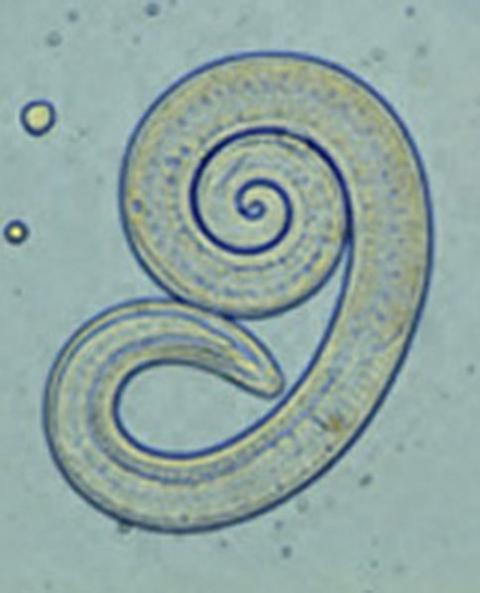
In the UK, the Food and Environmental Research Agency (part of DEFRA) has routinely screened foxes from across the country (supplied by gamekeepers, pest control officers and recovered as road kill) looking for this worm since 1999. The FERA programme for has screened several thousand foxes and, until recently, all had been negative. Indeed, the last confirmed case of Trichinella in a fox from Britain had been an animal from Truro in Cornwall caught during 1957. In recent years, however, in Northern Ireland two foxes have tested positive for the parasite.
In a brief paper to the journal Veterinary Parasitology during 2009, a team of 11 vets led by FERA biologist Irene Zimmer noted that, between 2003 and 2007, 483 foxes from across Northern Ireland were examined for Trichinella and one individual tested positive for larvae -- it was shot near Enniskillen, County Fermanagh during 2007. Subsequently, a single fox tested positive in 2009, also in Northern Ireland. In the Republic of Ireland, a survey of 454 foxes caught from across the country during 2002 found four infected animals (a prevalence of 0.9%): one in Waterford County, another in Donegal County and two in Cork County. Prior to the 2002 study, three animals from a sample of 70 foxes collected from the counties of Cork, Waterford and Tipperary during the late 1960s tested positive -- all infected animals were from West Waterford, indicating that reservoirs can be highly localised. A survey of 120 foxes from Limerick County in 1971 found two infected individuals.
The most recent data from Ireland, a study of 510 foxes from across the country by the Department of Agriculture Fisheries and Food Ireland conducted during 2008, found Trichinella larvae in two animals -- the national prevalence is thus considered to be 0.4% (or one in 255). In England, a positive fox was recorded during 2013. Ergo, despite being present, the parasite appears to have very low prevalence and, to the best of my knowledge, there are no data to suggest any humans have contracted trichinosis from foxes in the UK.
Outside of Britain, Red foxes are considered the main wildlife reservoir for Trichinella; the species most commonly found is T. britovi, although T. spiralis is also known, depending on the habitat. Prevalence of this worm in fox populations varies according to country, from low in Denmark and Spain (0.1% and 3% respectively) to very high (80%) in parts of Finland.
Some fox parasites can cause diseases in domestic animals and some of those of greatest concern include: Angiostrongylus vasorum and Sarcoptes scabiei.
Angiostrongylus vasorum (the canine heartworm)
Angiostrongylus vasorum is a roundworm parasite, first discovered in France during 1853, that causes chronic, sometimes fatal, infection in domestic dogs -- the worms grow and reproduce in the lungs and move into the heart causing, among other symptoms, coughing, breathing difficulties, anorexia, vomiting and weight loss. The larval worms are coughed up and swallowed, passing into the faeces; faeces are eaten by gastropods (slugs and snails) and these are then eaten by foxes or other dogs, passing on the infection. Wild foxes have been implicated in the spread of this worm, although the parasite does require this intermediate host (the gastropod mollusc) and doesn't appear to be passed directly from dog to fox or vice versa, although it seems that it may pass back-and-forth between dog and fox reservoirs.
This worm was first reported in Britain's foxes in 1995, when a young male fox was found wandering aimlessly in the Cornish village of Mousehole -- it was taken to a rescue centre but its condition deteriorated and it was euthanized. The post-mortem of this animal was carried out by Vic Simpson at the Veterinary Investigation Unit in Truro and he confirmed Angiostrongylus vasorum infection. In a paper to Veterinary Record during 1996, Simpson described a further three animals from Cornwall, examined between May and December the same year that were also found to be infected with this parasite. It is interesting to note that the first records of this parasite in domestic dogs in Britain came from Cornwall in the early 1980s, although there are insufficient data to draw conclusions.
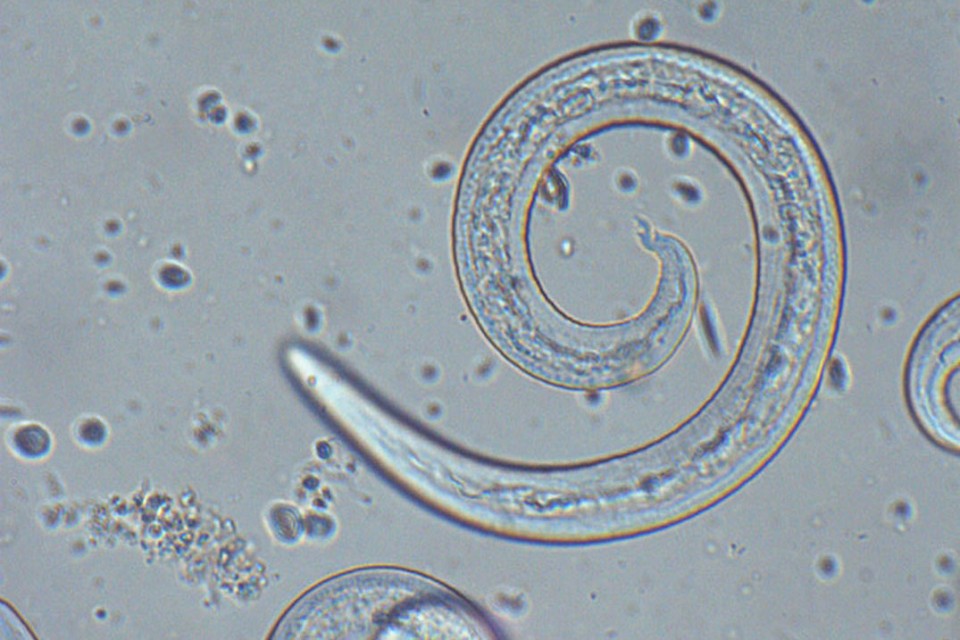
A recent survey by Central Science Laboratory (CSL) biologists of 546 foxes culled in Britain between 2005 and 2006 found that 40 animals were infected with A. variosum, giving an overall prevalence in the UK population of just over 7%. The level of infection varied according to region, with no reported cases from Scotland and northern England compared with an average prevalence of 23% (range 16% to 32%) in the south-east of England, which closely mirrors the perceived infection among domestic dogs. Despite these findings, the relative contribution of foxes to the spread of this parasite remains unknown and, in a recent letter to Veterinary Record, biologists at the CSL in York noted:
"Geographical spread of A. vasorum in the UK could be associated with the movement of foxes, the movement of molluscan intermediate hosts and/or the movement of dogs (including overseas travel)."
Currently, A. vasorum is known from Britain, Ireland, northern Spain and Portugal, France, Belgium, The Netherlands, Germany, Denmark, southern Sweden and Finland, Switzerland, Italy, Croatia, western Hungary and north-eastern Greece. Outside of Europe, it is also found in North America, parts of Asia (esp. Turkey) and Uganda in Africa. In Britain, it is widely considered that molluscs pose a greater threat of infection than foxes, and dog owners should ensure that their pets are vaccinated.
Sarcoptic mange
Sarcoptes scabei is a parasitic mite that causes sarcoptic mange in foxes; the condition can also be passed to domestic dogs and, occasionally, humans (although the mite tends not to survive long on a non-canid host). The newly-mated female mite burrows into the skin (several thousand may infest a single square-centimetre of skin in severe cases), feeding as she lays her eggs -- the irritation leads to intense itching and the associated scratching causes fur loss and wounds to the skin which can subsequently become infected. Without treatment, the condition is generally fatal within about four months.
Mange can have a significant impact on fox populations -- an outbreak in Sweden during the late 1970s caused a 95% reduction of fox density and populations remained low for 15 to 20 years. There have been many outbreaks in Britain and it has been hypothesised that mange was part of the reason fox numbers dropped sufficiently low to warrant imports from the continent during the mid-19th Century. In Bristol, an epidemic that began in 1994 caused a massive decline in fox numbers, with at least 90% of the animals dying. The subject of mange in foxes is covered elsewhere on this site in detail and the impact of such substantial reductions in population density are discussed in the Territory and Home Range section of the main Red fox article.
Viruses
In Europe and parts of North America the fox is a significant vector (carrier) of the rabies virus, which can be spread to humans and domestic animals. The subject of rabies in Red foxes is discussed at length elsewhere on this site and won't be reiterated here. A viral disease that can cause symptoms similar to rabies is canine distemper (CD) and this is occasionally recorded in foxes from Europe; unlike the rabies virus, which can only be spread through direct fluid injection (normally a bite), distemper is airborne.

The CD virus is a member of the Morbillivirus genus (part of the same family that causes mumps in humans) and, despite the development of vaccines against it, it is still a significant problem in central and eastern Europe -- a survey of foxes shot in Germany between 1996 and 1998 found 5% of animals sampled tested positive for the virus, the majority in urban areas. As far as I have been able to establish, there haven't been any confirmed cases of CD in British foxes, although epidemics of distemper have been known to occur elsewhere, causing considerable mortality locally in Europe and on fur farms. Fox encephalitis (a type of canine viral hepatitis) has been recorded from North America but not, as far as I can establish, from Britain.
Roundworms, tapeworms, flukes & protozoa
Looking at endoparasites more generally, the most common tapeworms found in foxes are Taenia spiralis and T. pisiformis, while the most common roundworms are Toxocara canis and Uncinaria stenocephala, which are found in the digestive tract. A 1976 study suggested that the intestinal tapeworm Mesocestoides was fairly common among foxes in Scotland and south east England. The Capillaria aerophila and Crenosoma vulpis worms have been found infecting the lungs of foxes and the Capillaria plica roundworm (bladder worm) is prevalent in parts of Europe -- a recent study found 78% of the foxes examined in southern Germany to have the parasite.
Recent work in Norway has shown that Red foxes can act as hosts for the protozoans Sarcocystis alces, S. hjorti, Eimeria, Isopora and Hammondia, some of which are important parasites of cervids (deer), especially moose; it's thought foxes may pick-up the parasites while feeding on moose carcasses. A recent study found low levels of the protozoan Cryptosporidium parvum (that causes the intestinal disorder cryptosporidiosis) in foxes from Ireland. The authors of the study, published in Veterinary Research Communications during 2007, note:

"Overall, this preliminary study, which represents one of the first published surveillance reports of Cryptosporidium in foxes, demonstrated the presence of C. parvum in our sampling of the Irish red fox population to be at a relatively low rate (1.6%)."
Foxes have also been found with Neospora canium and Toxoplasma gondii, parasitic protozoans that cause neosporosis and toxoplasmosis, respectively, in humans. During 1994 and 1995 a study of 16 foxes shot on a farm in Cornwall found two to be inconclusive and one to be "weakly positive" for Neospora antibodies (suggesting an old exposure to the parasite). So, despite living in an area where the disease was rife in livestock, the local fox population seemed largely free of the disease. The FERA study of 587 foxes from across Britain between 1999 and 2000 failed to find any infected with Toxoplasma, although a more recent study (published in 2009) found 20% of the foxes examined to have this parasite. Elsewhere in Europe, Toxoplasma prevalence ranges from 0% in Austria to 60% in Spain and Hungary. In Belgium one 1997 study found 98% of animals to be infected, while a more recent (2010) study found a prevalence of 19%.
Foxes are also susceptible to infection by various species of trematodes (flukes), including: Alaria alata, Heterophyes heterophyes and Echinostomum melis that live in the intestines; Opisthorchis conjunctus in the bile duct;O. felineus and Pseudamphistomum truncatum in the gall bladder; Metorchis albidus in the gall bladder and liver; and Microphallus similes, Maritrema linguilla, Cryptocotyl lungua, Echinochasmus perfoliatus and Paragonimus kellicotti in the lungs. In their 2025 paper to Parasitology International, Masahito Hidaka and colleagues reported 23 trematodes, which genetic analysis suggested were Brachylaima asakawai, were found in the small intestine of foxes (Vulpes vulpes schrencki) in Hokkaido, Japan -- the first record of this species as a carnivore parasite.
Finally, while studying wild foxes in Oxfordshire, David Macdonald at Oxford University observed that just over one-third of the 29 pairs of anal sacs he inspected were infected with nematode eggs. Macdonald noted that these eggs resembled those of the whipworm Trichuris trichuria. In his chapter on carnivores in Social odours in mammals, published in 1985, Macdonald wrote:
"The high proportion of infested sacs may suggest that they are a regular discharge point in the parasite's life cycle. Other foxes certainly sniff closely at discharged anal sac secretion and faeces, and may often lick them. One might speculate that an odour that was such a focus of attention ... would make an ideal transfer agent for a parasite."
Bacterial & fungal parasites
Finally on the subject of endoparasites, bacterial and fungal infections sometimes occur and can be fatal to foxes. In 1964 paper to the Veterinary Record, former Massey University (New Zealand) veterinary pathologist David Blackmore reported that eight (13%) of the 60 natural fox deaths he studied in Britain were caused by streptococci bacteria. A subsequent paper to the Journal of Wildlife Diseases, published in 1985, reported that foxes appear particularly susceptible to group G and C streptococcal infection, although the route of infection was found to be important; when the bacteria were injected into the muscle, they were considerably less virulent than when ingested (killing 17% and 100%, respectively). This study also found that, once the foxes had been exposed to (and survived) infection with either G or C streptococci, they were far less likely to succumb to subsequent infection with group G bacteria. This suggests that the foxes were able to launch an effective immune response against the infection. Blackmore, in his Veterinary Record paper, noted that infection may enter via fight injuries:
"From the limited number of examinations carried out, it would appear that streptococcal infection of British wild foxes is relatively common and that the infection usually gains entry via some traumatic lesion."
Foxes can also contract the bacteria Leptospira icterohaemorrhagiae, which causes Weil's disease. Rats are the main intermediate (carrier) host for this bacterium and, presumably, foxes contract this disease by eating rats; it's then passed to other foxes in their urine, which is an important territory marker. In his study of 91 wild foxes during the early 1960s, Blackmore found a high prevalence (61%) of nephritis (kidney inflammation), which he linked to Leptospiral infection. In 2009, DEFRA recorded 24 indigenous cases of Weil's disease (i.e., caught within the UK) and between 2000 and 2009 there were 528 cases.

I am not aware of any specific figures for Leptospira prevalence among Britain's foxes but, in their After the Hunt report for IFAW, the Bristol University team note that "Up to 70% of foxes" carry antibodies to this parasite (which implies exposure), although they don't cite the original study. To the best of my knowledge, there are no data on whether foxes are an important carrier of this disease. Other occasional bacterial pathogens include Proteus (P. vulgaris and P. mirabilis), Pasteurella, Listeria, Mycoplasma, Staphylococcus, Salmonella and Escherichia.
Mycobacterium bovis (the bacteria that causes bovine tuberculosis) has been recorded in foxes from Britain and Ireland, and was also recently isolated from a fox in the Doñana National Park in southwest Spain, although numbers are low (less than 1%) and none were infectious. Generally, foxes are not considered a significant carrier of this disease. Similarly, some farmers have suggested that foxes scavenging foetal membranes of livestock may spread the Brucella abortus bacterium that causes abortions in cattle. Antibodies for Brucella have occasionally been found from foxes in Britain and Northern Ireland (I'm only aware of one animal in which the bacteria itself was found) but, in their 2000 Report on Contract 5 to DEFRA, Bristol's Pirian White and colleagues wrote:
"It seems highly unlikely that foxes play even a minor role in the spread of brucellosis in the UK..."
Finally, on the subject of bacterial pathogens, Andreas Sing and colleagues reported Corynebacterium rouxii, the main etiological agent of diphtheria, in the spleen of one free-ranging female red fox in Germany during April 2014. I'm not aware of any other records of Corynebacterium from foxes.
In terms of fungal infections, ringworm (fungi of the Microsporum genus) is commonly encountered by rescue centres in the UK, although Trichophyton mentagrophytes (a related fungus) has also been recorded in foxes. It seems that foxes can pick-up ringworm from other species and, in a 2009 paper to the Iranian Journal of Veterinary Research, a team at the University of Tehran in Iran document the first case of a Red fox contracting Microsporum canis infection from an apparently healthy cat. In 1986, Osvald Settnes and colleagues found Pneumocystis carinii in 3 of 18 (17%) foxes they sampled in Denmark. More recently, Diana Riebold and her team found Pneumocystis fungi in the lungs of 29 of 62 (47%) red foxes killed as part of an anti-rabies campaign in Mecklenburg-Vorpommern in Germany during 2011. Pneumocystis can cause pneumonia in humans, although it's pathology is unknown in foxes.
The ectoparasites – fleas and ticks
The ectoparasites of foxes are typically fleas and ticks, of which there are many species. Fleas are probably the most commonly encountered and numerous ectoparasites and, in his 1957 study on the distribution and hosts of fleas in Britain, Frans Smit recorded seven species of flea on foxes: Pulex irritans (normally on man, badgers, pigs); Archaeopsylla erinacei (hedgehog flea); Ctenocephalides canis (dog flea); Spilopsyllus cuniculi (rabbit flea); Paraceras melis (badger flea); Malaraeus penicilliger mustelae (vole flea); and Monopsyllus sciurorum (Red squirrel flea). In a 1980 paper to the Journal of Zoology, Bristol biologists Alan Buckle and Stephen Harris reported that, in a sample of 252 foxes collected from suburban London between October 1971 and July 1973, 65 (26%) had fleas; of these, 40 carried a single species and 25 had mixed fleas of up to four species.

All in all, Buckle and Harris found eight species of flea from seven genera: Archaeopsylla erinacei; Paraceras melis; Orchopeas howardi (Grey squirrel flea); Spilopsyllus cuniculi; Ctenocephalides felis (cat flea); C. canis; Pulex irritans; and Nosopsyllus fasciatus (rat/mice flea). Other flea species recorded from foxes include two genera of fleas typically associated with rodents (Malaraeus and Monopsyllus), and two species of bird flea (Dasypsyllus gallinulae and Ceratophyllus gallinae).
Despite the considerable list presented here, in The Red Fox, Lloyd noted that foxes commonly carry dog fleas, but the other species are "stragglers", probably picked up from other animals; being predators, Lloyd suggested that foxes probably acquire fleas from many of their prey species. With this in mind, it is interesting that no bird fleas were found by Buckle and Harris; in their dietary analysis they found birds to be the most significant prey item, but hedgehog fleas were most common, despite hedgehogs rarely appearing in the diet.
Most flea species have co-evolved with their host such that they tend to be fairly host-specific (i.e., only survive on one or two species) and, in 1957, the eminent entomologist (insect researcher) George Henry Evans Hopkins described the flea Chaetopsylla globiceps as being unique to foxes. Jiri Preisler, of the State Veterinary Institute in Liberec, Czech Republic noted something similar in a 1983 paper to Folia Parastiologica; he found that this flea was widespread in Europe (although absent from Britain) and specific to Red foxes, with only the occasional flea collected from another carnivore. Preisler's collection at that time contained 4,744 of these fleas collected from 186 foxes, one polecat and one stone marten. Similarly, a recent study in Germany found that C. globiceps was occasionally found on species other than foxes (on three domestic dogs in their sample), but the prevalence was low (about 1%). Sometimes fleas may occur in considerable numbers and the largest "haul" that Preisler had was 237 fleas from a single fox. It should be noted that, despite the conclusions of Hopkins and Preisler, many authors consider that foxes don't have their own flea species.
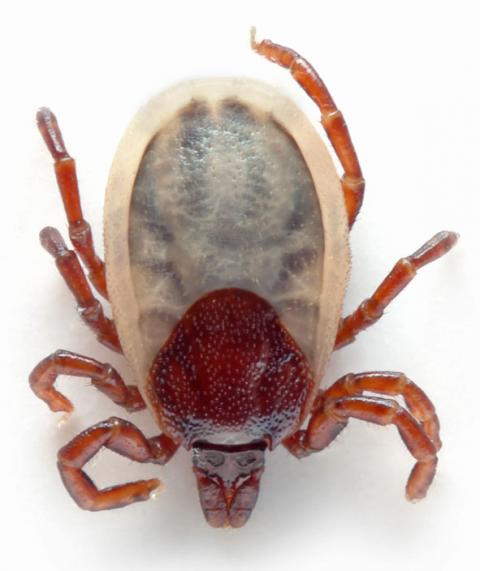
Foxes have also been recorded to carry ticks. Ticks are small members of the Arachnida class (which also contains the spiders and scorpions) that feed on their host's blood; they feed until gorged and then drop off in a process that generally takes eight to 16 days. In a sample of 331 foxes collected from suburban London between 1971 and 1973, Bristol biologists Stephen Harris and Gordon Thompson found only two species of tick (Ixodes hexagonus and I. canisuga, typically found on hedgehogs and dogs, respectively). In their literature review, published in the Journal of Zoology during 1978, Harris and Thompson note that hexagonus is more common in southern Britain and Ireland, while canisuga is common in the north. Indeed, in their sample, 108 (33%) foxes had hexagonus, while only 10 (3%) hadcanisuga, and one fox had both.
The researchers didn't find evidence of acquired immunity against the ticks (i.e., older foxes weren't less likely than younger ones to have ticks) and one female was severely infected (she had 315 adult ticks and 65 nymphs that caused several open sores seeping blood), but seemed otherwise healthy and above average weight. In his 1980 opus, Lloyd notes that foxes have also been found with Ixodes ricinus (sheep), I. negicallis, I. icuminatus and Dermacentor retulatus (cow tick). Once a tick has dropped off and digested its meal, it will sit and wait on vegetation for another suitable host to go past. Hence, the presence of ticks commonly associated with livestock is a result of the fox sharing the same habitat.
Foxes have been implicated in the spread of the zoonotic tick-borne encephalitis (TBE). In a 2008 paper to the Scandinavian Journal of Infectious Diseases, Paul Haemig and colleagues in Sweden found a positive correlation between the number of foxes and the number of cases of TBE in humans; as fox numbers increased, so did human TBE cases. Correlation doesn't, of course, equate to cause, but these findings have spurred further study.
Other ectoparasites that have been recorded on foxes include lice (Trichodectes vulpis is the usual louse found on foxes, although it is found infrequently) and the relatively harmless mite Trombicula autumnalis, which has frequently been observed on the ears and eyelids of foxes during September and October.
Other notable diseases
Finally, some of the more miscellaneous diseases from which foxes suffer include pneumonia, which is apparently a significant source of cub mortality, jaundice, paradontal disease, choking and hydrocephalus ("water on the brain"). In his 1980 book The Red Fox, Huw Gwyn Lloyd mentions a single case of a fox from Denmark with pseudorabies and foxes are occasionally found behaving in a manner suggestive of brain damage. Lloyd described how, in 1932, George Tickner reported three foxes near Oxford displaying "a kind of madness", including a male running in circles in a field snapping at air and ignoring the shouting people trying to drive it away; this appears to have been a result of some unknown brain injury causing cerebral lesions, rather than distemper.
Foxes also appear susceptible to bioaccumulation of heavy metals (which is of particular concern in areas where foxes are eaten by humans). A recent study in Poland found that, in coastal and island populations where foxes feed heavily on fish and fish-eating seabirds, they can be particularly susceptible to mercury bioaccumulation, especially in their kidneys, which can lead to central nervous system damage, including lethargy, various visual impairments, ataxia, limb paralysis, tremors, sensory and motor disorders.
So, in summary, foxes are hosts for an array of both internal and external parasites, some of which are important for human health. There is, however, no evidence to suggest that they are a significant vector for zoonotic disease in Britain.